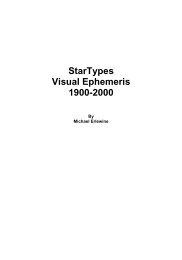The Art of Focus Stacking - Matrix Software
The Art of Focus Stacking - Matrix Software
The Art of Focus Stacking - Matrix Software
You also want an ePaper? Increase the reach of your titles
YUMPU automatically turns print PDFs into web optimized ePapers that Google loves.
<strong>The</strong> Good, the Bad, and the Ugly<br />
<strong>The</strong> Three People to Impress<br />
<strong>The</strong>y are, <strong>of</strong> course, “Me, Myself, and I,” the ones who<br />
really care about my photos. My wife, kids, and friends<br />
only want to see a very few photographs. After maybe<br />
ten or twelve, they start to look around. And I have<br />
100,000 plus. Other photographers like this, but want<br />
to change that, etc. This leaves just me as the one<br />
who sees it all, takes the photos, stacks them, and<br />
enjoys them. If I am happy with a photo, warts and all,<br />
that is enough.<br />
<strong>The</strong> following six two-page spreads will really let you<br />
know whether you want to play around with focus<br />
stacking or not. Going in, you should know upfront<br />
what the advantages and disadvantages <strong>of</strong> focus<br />
stacking are.<br />
Any stacked photo, in particular a short stack, is at<br />
best a comprise, an attempt to blend the sharper parts<br />
<strong>of</strong> a series <strong>of</strong> photos into a single photo. As with all<br />
compromises, the complete truth by definition is violated,<br />
hopefully in as few ways as possible, but some<br />
information is lost because we are selecting layers <strong>of</strong><br />
the photo rather than a single shot.<br />
This is why I say that short-stacked photos are the<br />
photographer’s ‘impression’ <strong>of</strong> the subject. <strong>The</strong>y combine<br />
a series <strong>of</strong> desirable photo layer/highlights into a<br />
single photo. As focus stackers, we choose to create<br />
an artfully-flawed photo that gives a more desirable<br />
impression that any single-focus photo. That is the<br />
theory and this is where the art comes in. <strong>The</strong> art <strong>of</strong><br />
focus stacking is to sample focus effectively so that<br />
the finished photo provides more information than any<br />
single-layer photo might.<br />
And by ‘information’, I don’t mean just the pixels in the<br />
photo. A single-shot traditional photo <strong>of</strong>fers that. <strong>Focus</strong><br />
stacking (short-stack) attempts to sample the subject<br />
selectively, bringing different areas <strong>of</strong> the photo into<br />
higher focus and ignoring the rest.<br />
Beginning focus stackers naturally try to get everything<br />
they can into focus because it is a relief from<br />
traditional photos that dictate one main focus area. It<br />
is fun to finally see all that focus clarity. But as time<br />
goes by, just pure focus (like with a rack) is not only<br />
very time consuming but is not always satisfying. In<br />
addition, the existence <strong>of</strong> artifacts at close inspection<br />
can be discouraging. In the end, focus stacking is impressionistic,<br />
a creative effort on our part to present a<br />
subject as we experience it.<br />
In the following pages one stacked photo is compared<br />
at different stacking rates to an un-stacked traditional<br />
photo. For this example, I am using a 12-stacked photo<br />
taken in the wild but with the help <strong>of</strong> a light tent to<br />
make sure that no wind was moving the subject, which<br />
in this case is the Dogtooth Violet (also called “Trout<br />
Lily”), one <strong>of</strong> our most lovely spring flowers. This one<br />
is getting ready to open. <strong>The</strong> forest floors are literally<br />
covered with the mottled leaves <strong>of</strong> this plant in springtime,<br />
and from all those leaves some smaller number<br />
<strong>of</strong> flowers bloom each year.<br />
Twelve stacks is a bunch, enough to embrace quite a<br />
wide range, from the front leaf tips in the close foreground,<br />
the flower itself, to the back leaf leaning the<br />
other way – quite a reach.<br />
At first glance, things are in focus, from the front<br />
to the back. Note the tips <strong>of</strong> the leaves, the<br />
top <strong>of</strong> the flower, the stems, and even some <strong>of</strong><br />
the dry tree leaves making up the background<br />
which I purposely did not drill down on, preferring<br />
some out-<strong>of</strong>-focus areas. <strong>The</strong> photo looks<br />
pretty good. I have not color corrected it or anything<br />
else, other than a little bit <strong>of</strong> sharpening.<br />
29

















